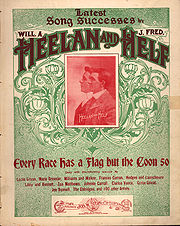
Every Race Has a Flag but the Coon
Encyclopedia

Coon song
Coon songs were a genre of music popular in the United States and around the English-speaking world from 1880 to 1920, that presented a racist and stereotyped image of blacks.-Rise and fall from popularity:...
written by Will A. Heelan
Will A. Heelan
Will A. Heelan was an American lyricist during the early 20th century. He collaborated with a number of composers and lyricists including E. P. Moran, Seymour Furth, J...
and J. Fred Helf
J. Fred Helf
J. Fred Helf was an American composer and sheet music publisher during the early 20th century.Helf was born in Maysville, Kentucky. He went to seek his fortune in New York City at the age of 31. There he composed over 100 songs, some in collaboration with Will A. Heelan.In October 1910 his music...
that was popular in the U.S. and Britain. The song followed the previous success of "All Coons Look Alike to Me", written in 1896 by Ernest Hogan
Ernest Hogan
Ernest Hogan was the first African American entertainer to produce and star in a Broadway show and helped create the musical genre of ragtime....
. H.L. Mencken cites it as being one of the three coon songs which "firmly established the term coon in the American vocabulary". The song was promoted as one of the greatest musical hits of the day by A.M. Rothschild and Company in 1901. New York's Siegel Cooper Company referred to it as one of the "hits of the day" in April a year later. The next month it was sung during "Music on the Piers" in New York, being the first song played at the Metropolitan Avenue pier. In his book The Movies That Changed Us: Reflections on the Screen, Nick Clooney
Nick Clooney
Nicholas Joseph "Nick" Clooney is an American journalist, anchorman, and television host. He is the brother of the late singer Rosemary Clooney, and father of actor and film director George Clooney.-Early life:...
refers to the song as part of the "hit parade" of popular music one could use to measure the temper of the times when The Birth of a Nation
The Birth of a Nation
The Birth of a Nation is a 1915 American silent film directed by D. W. Griffith and based on the novel and play The Clansman, both by Thomas Dixon, Jr. Griffith also co-wrote the screenplay , and co-produced the film . It was released on February 8, 1915...
premiered in 1915. The tune is repeatedly referred to in the literature as having the ability to incite violence merely by its being whistled in the direction of an African American. It was also Marie Dressler's
Marie Dressler
Marie Dressler was a Canadian-American actress and Depression-era film star. She won the Academy Award for Best Actress in 1930-31 in Min and Bill.-Early life and stage career:...
contribution to the 'coon' genre. Lottie Gilson
Lottie Gilson
Lottie Gilson was a popular comedienne and vaudeville singer born in 1871 in Pennsylvania who died in New York in 1912.She was known as "The Little Magnet" in recognition of her considerable abilities to boost sheet music sales during the 1880s and 1890s....
, Williams and Walker
Bert Williams
Egbert Austin "Bert" Williams was one of the preeminent entertainers of the Vaudeville era and one of the most popular comedians for all audiences of his time. He was by far the best-selling black recording artist before 1920...
, Frances Curran, Hodges and Launchmere, Libby and Bennett, Zoa Matthews, Johnnie Carroll, Clarice Vance
Clarice Vance
Clarice Vance née Clara Etta Black , "The Southern Singer" was an American vaudeville personality from the late 19th century to about 1917.-Early life and marriage:...
, Gerie Gilson, Joe Bonnell, The Eldridges and "100 other artists" sung the song with "overwhelming success" according to its sheet music.
The song motivated the creation of the Pan-African flag
Pan-African flag
The Pan-African flag, also referred to as the UNIA flag, Afro-American flag or Black Liberation Flag, is a tri-color flag consisting of three equal horizontal bands colored red, black and green. It was originally created as an official banner to represent an international community for all African...
in 1920 by the members of the Universal Negro Improvement Association and African Communities League
Universal Negro Improvement Association and African Communities League
The Universal Negro Improvement Association and African Communities League is a black nationalist fraternal organization founded by Marcus Garvey. The organization enjoyed its greatest strength in the 1990s, prior to Garvey's deportation from the United States of America, after which its...
.
In a 1921 report appearing in the Africa Times and Orient Review, Marcus Garvey
Marcus Garvey
Marcus Mosiah Garvey, Jr., ONH was a Jamaican publisher, journalist, entrepreneur, and orator who was a staunch proponent of the Black Nationalism and Pan-Africanism movements, to which end he founded the Universal Negro Improvement Association and African Communities League...
was quoted as saying,
"Show me the race or the nation without a flag, and I will show you a race of people without any pride. Aye! In song and mimicry they have said, "Every race has a flag but the coon." How true! Aye! But that was said of us four years ago. They can't say it now...."
The lyrics to "Every Race Has a Flag but the Coon" include the musical meme "four eleven forty four"
Four Eleven Forty Four
Four Eleven Forty Four or 4-11-44 is a phrase that has appeared repeatedly in popular music and other popular culture, either as a reference to numbers allegedly chosen commonly by poor African Americans while gambling, or to the combination of width and length of a penis, through multiplication of...
.

